Ask ten founders to show you their marketing strategy, and five will say, “We’re still working on it.” The other five will show you something that reads like it came from a motivational poster.
Neither of those is helpful.
Writing the marketing strategy in your business plan isn’t rocket science. However, it only works when it connects with the essential business plan components. And that’s the part most people either skip or overcomplicate. You’ve probably seen stuff like: “We’ll scale through content, community, and omnichannel growth.”
Sure. But what does that actually mean?
In this blog, we’ll show you a better way, which is writing a marketing strategy that makes sense, sounds real, and doesn’t get ignored.
What is a marketing strategy (in your business plan)
A marketing strategy in a business plan explains how you plan to reach your customers and convince them to buy. It covers what you’re offering, who it’s for, and how you’ll promote it using social media, email, ads, or partnerships.
This section should be easy to understand and based on real choices. That means saying exactly who you want to target, where you’ll find them, and how you’ll get their attention.
It doesn’t need to be perfect. But it does need to show that you’ve thought things through. The goal is to make someone reading your plan say, “Okay, this business knows how to get customers.”
How do you create a solid marketing strategy for your business?
If your strategy’s all over the place, your results will be too. Let’s walk through the steps to build one that’s actually useful.
1. Define your marketing objectives
Let’s start with something a lot of people skip: setting real goals. And no, “get more customers” doesn’t count. That’s nice, but it doesn’t help you build a plan or measure progress.
What you need are specific goals with numbers and timelines. And those goals should always tie back to your bigger picture. That’s why it helps to set business goals before diving into the strategy.
Something you can actually track and say, “Yep, we hit that” or “Okay, that flopped, let’s fix it.”
A proper marketing objective looks like this: Get 500 new signups in the next 3 months, reach 10,000 website visitors in Q2, hit a 30% open rate on our weekly newsletter, cut churn by 15% in one quarter, or generate 100 qualified leads from Facebook ads by next month.
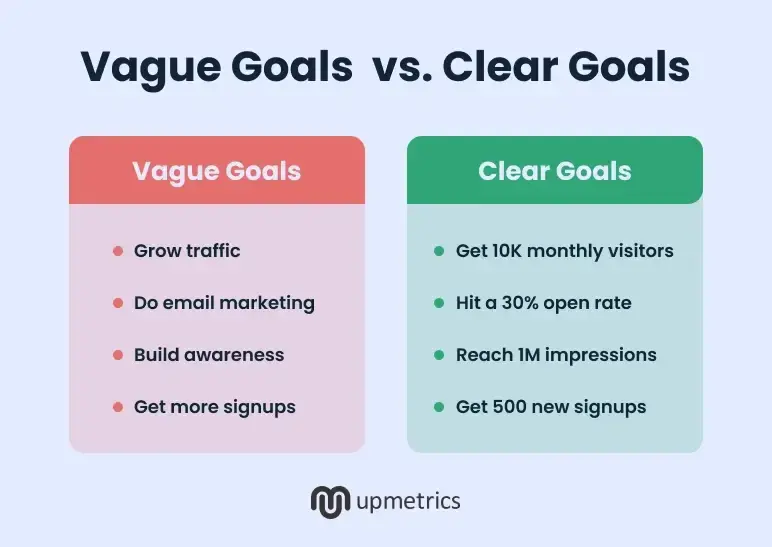
See the difference? They’re targets. You know when to check them, and you know if they worked. Without clear objectives, you’re just testing things at random. Some of it might work, some might not, but you won’t know why. And that’s a fast way to waste time and budget.
2. Understand your target market
This step starts with solid customer analysis—understanding who they are, what they care about, and what they’re trying to solve.
But before you build your marketing plan, you need to be clear on one thing: who exactly are you trying to reach? This starts with good customer analysis.
The more specific you are, the more useful your strategy will be. Marketing works best when it’s built around a real group of people.
Start with the basics. Ask yourself:
- How old are they?
- What kind of work do they do?
- What’s frustrating them right now that your product or service can actually fix?
These answers shape everything, from your messaging to your budget. If you skip this step, the rest of your plan will always feel a bit off.
Let’s say you’re building an online design tool. If you say your audience is “people who design stuff,” you’ve already lost the plot. A stronger target would be: “Freelance designers aged 25–40 who want a faster, cheaper alternative to Adobe and work primarily with small business clients.”
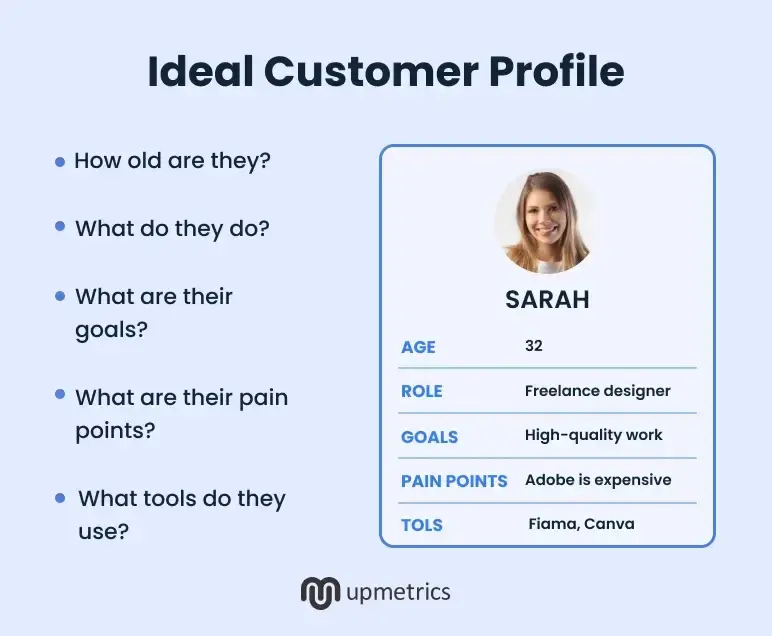
Now, your messaging can be way more focused.
To make it easy, start with your current customers. Where did they come from? What do they say about you in reviews or feedback? And if you’re new, go check your competitors. Look at their testimonials and 1-star reviews. You’ll learn fast what people love or can’t stand.
3. Conduct a SWOT analysis
If you want your marketing plan to make sense, start by looking at where your business actually stands. A quick SWOT analysis helps you do exactly that. Here’s how it works:
Break things down into four areas:
- Strengths: What are you good at? What’s working?
- Weaknesses: What’s slowing you down or holding you back?
- Opportunities: Where could you grow or gain more traction?
- Threats: What outside factors could hurt your progress?
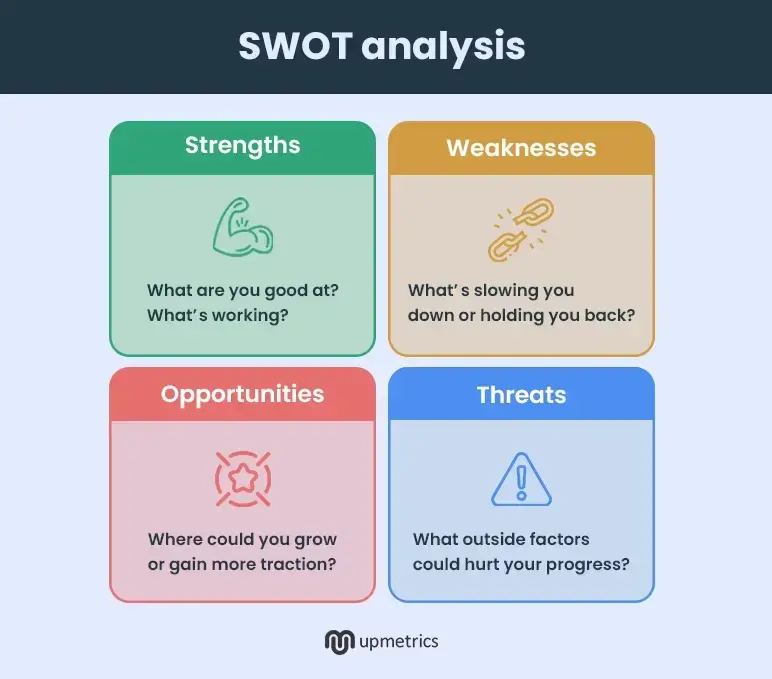
Simple. But it’s surprisingly useful when you’re figuring out what to focus on and what to watch out for.
If you run a boutique skincare brand. Your strength might be high-quality, natural ingredients. Great. But your weakness? Maybe no one knows about you yet. That means your opportunity is visibility—SEO, social media, and PR. And your threat is that larger brands are jumping on the clean skincare trend with bigger budgets.
Now, you’re not just saying, “We’ll run ads.” Back it up with a proper market analysis for a business plan.
4. Determine your unique value proposition (USP)
This is where you explain, in one or two sentences, why someone should choose your product or service over anyone else’s. That’s it. No long pitch. No filler.
Your unique value proposition is the clear benefit you’re offering to your target customers. It could be speed, price, quality, simplicity, or a feature nobody else has. Whatever it is, make it obvious.
Your USP is the reason someone chooses you over a hundred similar-looking options. It’s what you do better, faster, cheaper, smarter, or in a way that actually solves the customer’s real problem.
It should be clear, believable, and, ideally, something your competitors can’t just copy overnight. If someone reads it and goes, “Okay, that’s useful,” you’re on the right track.
Let’s say someone runs a virtual assistant platform. Instead of saying, “We have great VAs,” they can say: “Same-day onboarding. U.S.-based support. No lock-in contracts.” That’s specific. That sets expectations and gives people a reason to choose you.
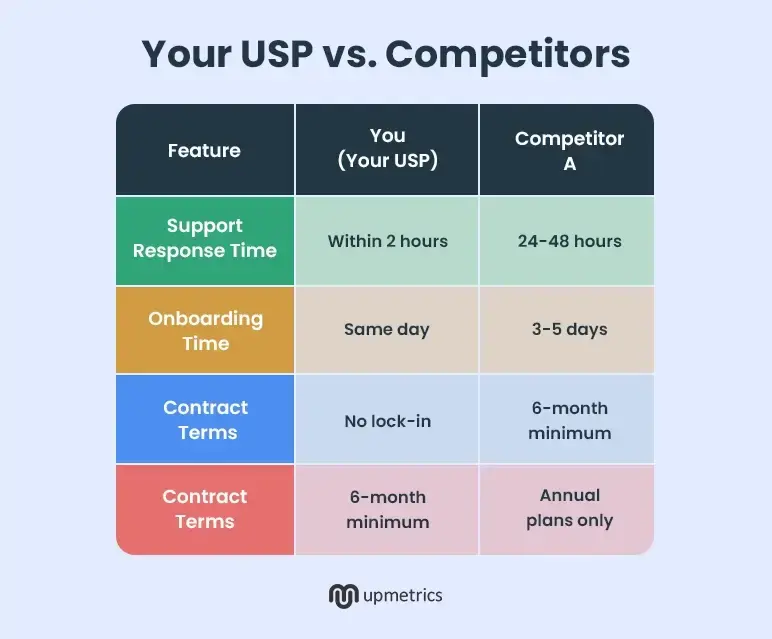
Don’t list your USP as “we care” or “we’re passionate.” Everyone says that. No customer reads that and thinks, “Finally, someone who cares.” A good USP tells customers what you’ll do for them that others won’t. “Our support team replies within 2 hours. Always.” Now we’re talking.
5. Choose your marketing channels
Once you’ve figured out who your audience is, the next question is: Where do they actually spend time? That’s where your marketing needs to show up.
You don’t need to be everywhere. You just need to be where it counts. Spreading yourself across five platforms won’t work if your audience only checks two of them. And unless you have a full team, you won’t keep up anyway.
Pick the platforms your audience already uses. That’s it.
If you’re selling to working professionals, LinkedIn and email newsletters are solid bets. If you’re selling trendy water bottles to Gen Z, you need TikTok and maybe Instagram Reels.
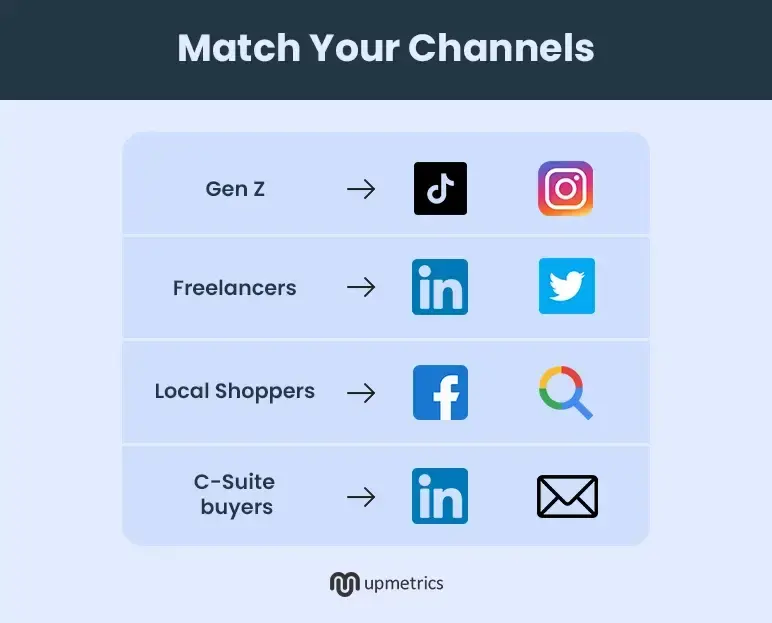
These choices shape everything that follows in your marketing plan. For starters, pick 2–3 platforms that match your audience. Stick with them for a few months, test different content, and track results. If it’s working, double down. If it’s dead quiet, don’t be afraid to pivot.
6. Set your marketing budget
Marketing costs money. How much? That depends on what you’re doing, but you need a number. A real one. Not “we’ll figure it out later.”
Look at your total business budget. Then, decide what portion of it will go to marketing. A lot of early-stage businesses put 5–15% of projected revenue into marketing. If that sounds like a lot, think of it this way: If no one knows you exist, the rest of your business plan doesn’t matter.
Once you know your budget, split it into chunks. Think about where your audience spends time—and where you’ll spend money trying to reach them. For example:
- 50% for online ads (Facebook, Instagram, Google)
- 30% for content (blog posts, videos, design)
- 20% for other stuff like events, email tools, sponsorships, etc.
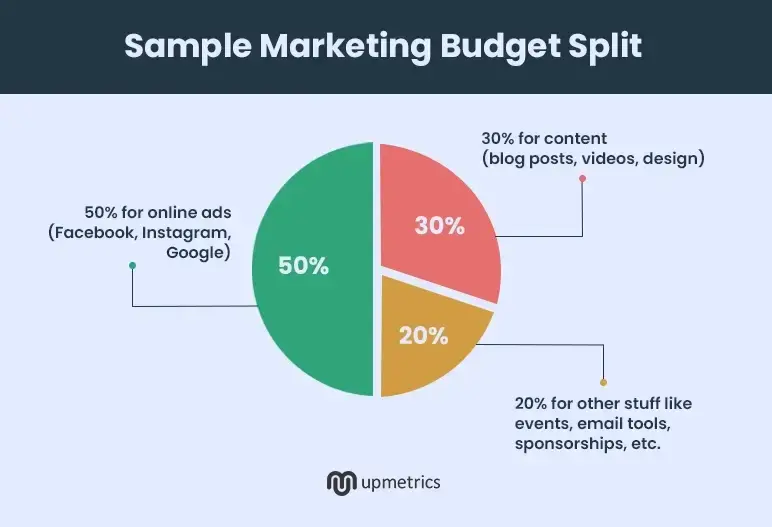
This helps you stay focused. You won’t waste time wondering if you can “afford” to run an ad or hire a freelancer.
Also, leave a little room for last-minute things. Sometimes, campaigns shift, or something performs better than expected. It’s smart to have a small buffer instead of pulling from other areas later.
7. Define your KPIs (Key Performance Indicators)
Once your marketing plan is live, you need a way to tell if it’s actually working. That’s where Key Performance Indicators help. Basically, they’re the numbers that show whether your efforts are paying off or just burning through your time and budget.
You don’t need to track a million things. Just focus on 3 to 5 key metrics that directly match the goals you’ve already set. That’s enough to keep things clear without drowning in data.
Here are a few KPIs that are actually worth tracking:
- Cost per lead: How much do you have to spend to get one person interested?
- Conversion rate: Out of all those leads, how many actually buy?
- Email open rate: Are people even opening your emails, or are they sitting unopened next to 37 others?
- Click-through rate (CTR): If you’re running ads, are people clicking or just scrolling past?
- Customer acquisition cost (CAC): How much does it cost to turn a lead into a paying customer?
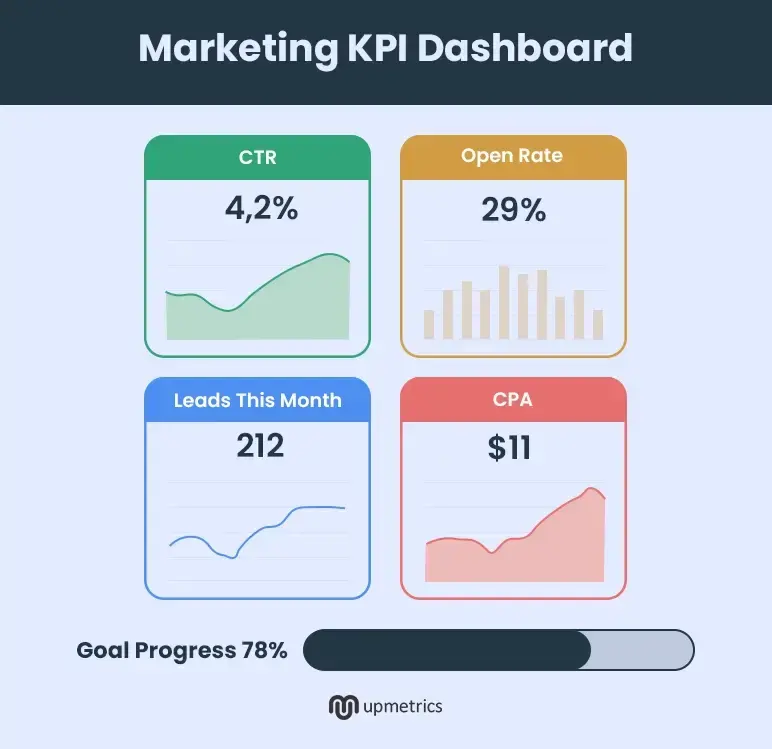
Stick to the ones that connect directly to your goals. It’s tempting to track everything, but it’s better to focus on the numbers that actually tell you what’s working right now.
Present your strategies in your business plan: follow this structure
If you’ve been wondering, “Okay, but what does this look like in a real plan?”—here’s your answer. The example below shows a full marketing strategy written clearly and concisely for Nature’s Crunch Snacks. Just a structure you can follow, tweak, or use for inspiration.
Target market
We’re focused on health-conscious adults aged 20–40 living in cities—people who work long hours, care about what they eat, and want snacks that actually fuel them.
Most of our customers hit the gym, work remotely, or are always on the go. Think busy professionals, fitness junkies, and anyone who’s tired of snacks that taste like cardboard.
Value proposition
Nature’s Crunch offers a high-protein, low-sugar snack made with 100% organic ingredients and zero weird additives. It’s clean, satisfying, and tastes good without making people feel guilty. We’re not promising “superfood miracles.” It’s just a bar that does its job without the junk.
Marketing goals
- Launch in 3 major cities
- Sell 10,000+ bars/month within 6 months
- Reach 20,000 Instagram followers by year-end
- Achieve a 30% repeat purchase rate in Year 1
These goals are directly tied to launch traction, brand visibility, and long-term retention.
Pricing strategy
We’re priced at $2.50 per bar, slightly higher than average but in line with other organic and fitness-focused brands. It signals quality without being out of reach. We’ll offer:
- Mix-and-match bundles
- Subscription boxes with discounts
- Seasonal promos (e.g., first-order 15% off)
The goal is to raise the average order value and keep people coming back without relying on constant discounting.
Promotion & advertising
We’ll go all in on platforms where our audience already hangs out:
- Instagram + TikTok: fitness tips, product demos, user stories
- Paid ads targeting urban professionals, gym-goers, and nutrition-conscious shoppers
- Influencer shoutouts and samples with fitness coaches and dietitians
Offline, we’ll show up at convenience stores, supermarkets, pop-ups, and health expos to give out samples and build direct connections.
Sales & distribution
We’ll sell online through our website (with free shipping for orders over $30) and through Amazon. Locally, we’re launching with 15 retail spots—health food stores, boutique gyms, and wellness cafés. Orders are packed and shipped from our partner fulfillment center, with 3–5 day delivery nationwide.
If we hit our targets in the first year, we’ll look at larger regional retailers and subscription box partnerships in Year 2.
Customer retention
Here’s how we’ll keep customers around:
- A subscription program with monthly deliveries + a 10% discount
- A weekly email newsletter with workout tips, new product updates, and featured customer stories
- A feedback loop. Every comment about taste or delivery goes to our product team
- UGC and referral campaigns: “Tag us with your favorite snack moment” and “Give 20%, get 20%.”
We want people to stick with us, not just because they like the bar, but because they feel part of the brand.
If you’re writing your own marketing strategy, you can follow this same format. Just replace the snack bar details with your product or service, stay clear on who you’re targeting, and make sure your goals and tactics actually match how your customers behave.
How do you align your marketing strategy with your overall business plan?
Your marketing strategy needs to back up your business goals. If your plan says you’re entering a new market, your marketing should show how you’ll reach those people. If you’re aiming to boost retention, your campaigns should do more than just chase new clicks.
It’s all about consistency. Messaging, tone, offers, and everything should feel like it’s coming from the same brain. Otherwise, your team gets confused, your customers get mixed signals, and your strategy ends up working against itself.
Conclusion
You’ve seen the structure. You know the steps. You’ve even got examples. Now it’s time to stop collecting tabs and start building your marketing strategy for real.
If the blank page still feels intimidating, try using Upmetrics. It’s made for people who want to get their business plan done without spending days formatting or figuring out what goes where. You bring the ideas, and it helps you shape them into something solid.
Now you’ve got what you need. Time to actually write it.


